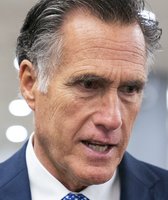Stand up for the facts!
Our only agenda is to publish the truth so you can be an informed participant in democracy.
We need your help.
I would like to contribute
In his administration’s earliest weeks, President Donald Trump has worked to deliver on major campaign promises that could impact millions of immigrants living in the country illegally.
Trump’s immigration policy as commander in chief has mostly been in line with his campaign rhetoric. A flurry of executive orders cast a wide net for people who will become deportation priorities and authorized the construction of a border wall with Mexico.
But Trump has held back on at least one promise for which he pledged prompt action: Recipients of a deferred action program Trump said he would terminate immediately for now have seen no changes.
Here’s a rundown of some major issues outlined in Trump’s executive orders and in implementation memos issued by Homeland Security, the department tasked with enforcing immigration laws.
Border wall planning in early stages
Sign up for PolitiFact texts
Trump’s promise to build a wall along the U.S.-Mexico border is In the Works. An executive order signed Jan. 25 directs the DHS secretary to "take all appropriate steps to immediately plan, design, and construct a physical wall along the southern border, using appropriate materials and technology to most effectively achieve complete operational control of the southern border."
In an implementation memo issued Feb. 20, DHS Secretary John Kelly instructed U.S. Customs and Border Protection to consult with other executive departments and agencies on the immediate planning, design, construction and maintenance of the border wall. The memo directs the use of materials originating in the United States "to the maximum extent permitted by law."
Border Patrol is assessing priority areas where a wall or similar physical barriers can be built, DHS said. The department has identified locations near El Paso, Texas; Tucson, Ariz.; and El Centro, Calif., for wall construction as the fencing in place is "no longer effective."
Currently, there are 702 miles of fencing along the nearly 2,000-mile U.S.-Mexico border. It includes 652 miles of primary fencing, 36 miles of secondary fencing and 14 miles of tertiary fencing, according to U.S. Customs and Border Protection.
Expanded categories of immigrants in deportation priorities
Trump has emphasized that his administration’s top priority for deportations will be criminals and people who pose threats to public safety.
Overall, Trump’s net is wider than his predecessor’s. The language in Trump’s official directive and in DHS implementation memos indicate that an individual who is in the country illegally is also prioritized for removal, even if they have not been convicted of crimes.
"Under the executive order, (U.S. Custom and Immigration Enforcement) will not exempt classes or categories of removable aliens from potential enforcement," said a DHS fact sheet. "All of those in violation of immigration law may be subject to immigration arrest, detention and, if found removable by final order, removal from the United States."
As of Feb. 6, ICE had 12,370 individuals in custody with final orders of removal from immigration judges, according to an ICE official. An additional 960,483 individuals had final removal orders but were not in ICE custody.
Obama had three priorities. At the top were convicted criminals, public safety threats, and individuals apprehended at the border while attempting to cross illegally. The second priority was individuals convicted of significant misdemeanors, anyone caught anywhere in the United States after illegally crossing the border who could not prove they had been in the country since the beginning of 2014, and individuals who had significantly abused visa programs. The third priority were people issued final removal orders after 2013.
ICE and border patrol agents have realigned their priorities to meet Trump’s executive order, DHS said. Among individuals prioritized in that order are those who have been charged with a criminal offense, even if not yet convicted; have committed an act that may be a chargeable criminal offense; have abused programs issuing public benefits; or have been convicted of murder or engage in terrorist activities.
The deportation of "all criminal aliens" is a Trump campaign promise we’ve rated In the Works.
Expansion of controversial immigration program
Trump has ordered the expansion of an immigration program called 287(g), which has a history of racial profiling allegations.
Named for a section of immigration law, 287(g) allows ICE to enter into agreements with state and local law enforcement agencies and train officers to carry out immigration law enforcement.
ICE has these agreements with more than 30 law enforcement agencies in 16 states, including Florida, Texas and Arizona. ICE credits the program for identifying more than 402,000 "potentially removable aliens" from January 2006 through Sept. 30, 2015.
The program has had two enforcement models: a task force, in which officers patrolling the streets could approach and process "removable aliens," and a jail model, allowing officers in state and local detention facilities to process removable aliens charged with or convicted of an offense.
In 2012, the Obama administration decided to end the task force model. As a result, trained local police only questioned people about their immigration status after being booked into jail.
In December 2011, DHS said the Justice Department found "discriminatory policing practices" within the Maricopa County Sheriff’s Office, run by then Sheriff Joe Arpaio, and terminated the county’s jail mode agreement. In 2009, DHS had decided not to renew Maricopa County’s task force model agreement.
In describing how to implement Trump’s Jan. 25 order, Kelly said getting state and local authorities to help execute federal law is "critical to an effective enforcement strategy."
‘Dreamers’ get a break
The Trump administration released a memo Feb. 20 that rescinded all previous directives regarding enforcement priorities — with an exception for a 2012 memo that outlined prosecutorial discretion for immigrants who came to the country as children.
The decision impacts more than 740,000 people (commonly called Dreamers) who have been granted protection under a program called Deferred Action for Childhood Arrivals (DACA), created during Obama’s administration.
As a candidate, Trump called DACA "unconstitutional," "illegal" and said he would terminate the program "immediately." Trump has embraced a more sympathetic tone toward this group since the election.
"The DACA situation is a very difficult thing for me as I love these kids, I love kids, I have kids and grandkids and I find it very hard doing what the law says exactly to do and, you know, the law is rough," Trump said in a press conference Feb. 16.
A 23-year-old who had been granted deferred deportation protection was detained by immigration authorities Feb. 10 in Washington state. ICE said he was arrested based on admitted gang affiliation and risk to public safety, though his lawyers have denied claims of gang affiliation.
Hiring thousands of additional immigration enforcement agents
Trump campaigned on a promise to triple the number of ICE agents. As president, he signed executive orders directing the Homeland Security secretary to hire 10,000 additional ICE officers and 5,000 more border patrol agents. We’ve rated this promise In the Works.
At a hearing before House representatives, Kelly warned not to expect 15,000 new immigration enforcement employees hired immediately, emphasizing a preference to have a well-trained staff over a larger workforce that might not meet standards.
"I don't believe we're going to get 10,000 and 5,000 on board within the next couple of years. I'd rather have fewer and make sure that they're high quality people that are already serving in those organizations, already well-trained, but I will not skimp on the training and the standards," Kelly said Feb. 7.
The Department of Homeland Security has more than 240,000 employees. Within the department, there are about 20,000 ICE employees, including an estimated 5,800 who identify, apprehend and remove deportable immigrants. There are slightly over 21,000 border patrol agents.
Other policy changes worth noting:
- Trump signed an order instructing the attorney general's office to identify cities refusing to comply with U.S. law and to ensure they do not receive federal grants. It also directed the DHS secretary to designate jurisdictions as sanctuary cities. We rated this campaign promise In the Works.
- At campaign events, Trump often cited cases of Americans killed by immigrants in the country illegally. To assist victims’ families, Trump’s administration is establishing the Victims of Immigration Crime Engagement Office to offer families information about offenders, including their immigration and custody status. Kelly instructed ICE’s director to reallocate resources used to advocate on behalf of undocumented immigrants to VOICE.
- Kelly ordered a stop to the practice of "catch and release," or releasing immigrants caught illegally crossing the border. Some immigrants used to be released pending a hearing of their case. Advocates have said this practice has been in place due to lack of detention space and because some cases take years to resolve. Kelly’s memo said the detention of immigrants is the best way to enforce immigration laws, prevent them from committing crimes, ensure their appearance before hearings and increase likelihood of their removals.
- Unaccompanied minors arriving at the border and who do not have a parent or legal guardian in the United States will be offered special protections. They’ll be transferred to the Office of Refugee Resettlement within the Department of Health and Human Services and given access to social services and can present their case before an immigration judge. Thousands of children, mostly from Central America, have made their way across the border fleeing violence and poverty. About 60 percent of minors at first considered "unaccompanied alien children" are placed with parents living in the Unites States illegally, DHS said. Though that’s been department practice and policy, placing a child in a parent's custody may lead to the child no longer meeting the statutory definition of unaccompanied alien children, Kelly’s memo said. Kelly directed agencies within his department to develop written guidance and training for proper processing.
- DHS will not extend Privacy Act rights and protections to individuals who are not U.S. citizens or lawful permanent residents
Our Sources
White House, executive orders
Department of Homeland Security, fact sheets
Department of Homeland Security, OIG report on the Performance of 287(g) Agreements, March 2010
Department of Homeland Security, implementation memos, Feb. 20, 2017
PolitiFact, Trump-O-Meter immigration promises
PolitiFact, Trump says Secure Communities, 287(g) immigration programs worked, Sept. 6, 2017
PolitiFact Texas, Ted Cruz: Obama administration released 104,000 'criminal illegal aliens' including 196 murderers, Aug. 28, 2015
New York Times, Constraints Threaten Trump’s Promise of an Immigration Crackdown, Feb. 17, 2017
Reuters, Trump's plan to halt 'catch and release' of migrants could hit a wall, Jan. 26, 2017
U.S. Immigration and Customs Enforcement, Delegation of Immigration Authority Section 287(g) Immigration and Nationality Act




































